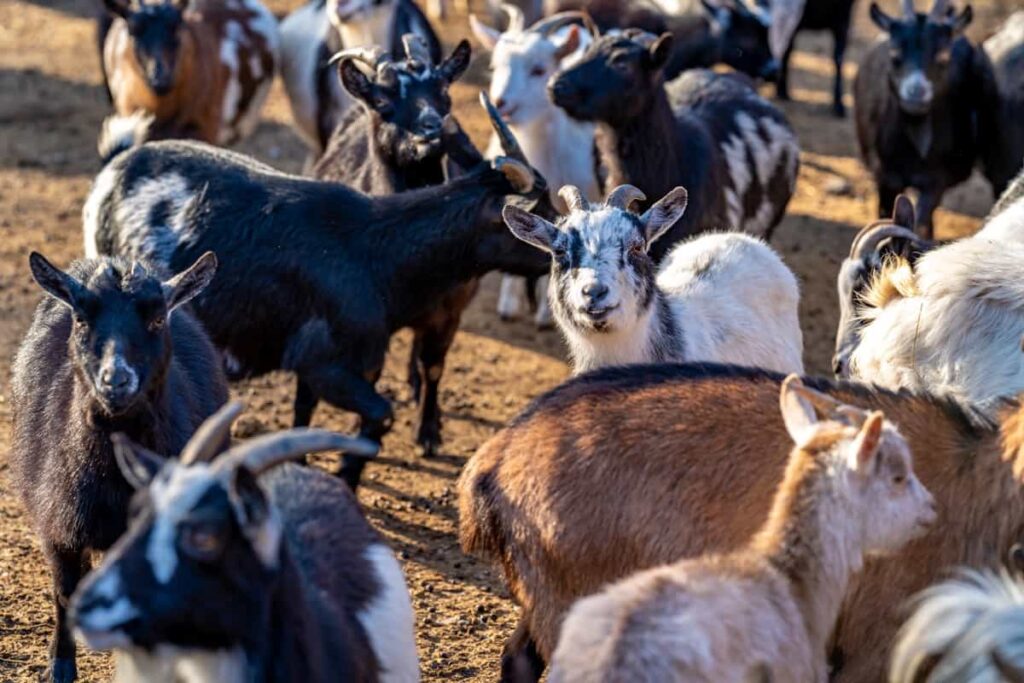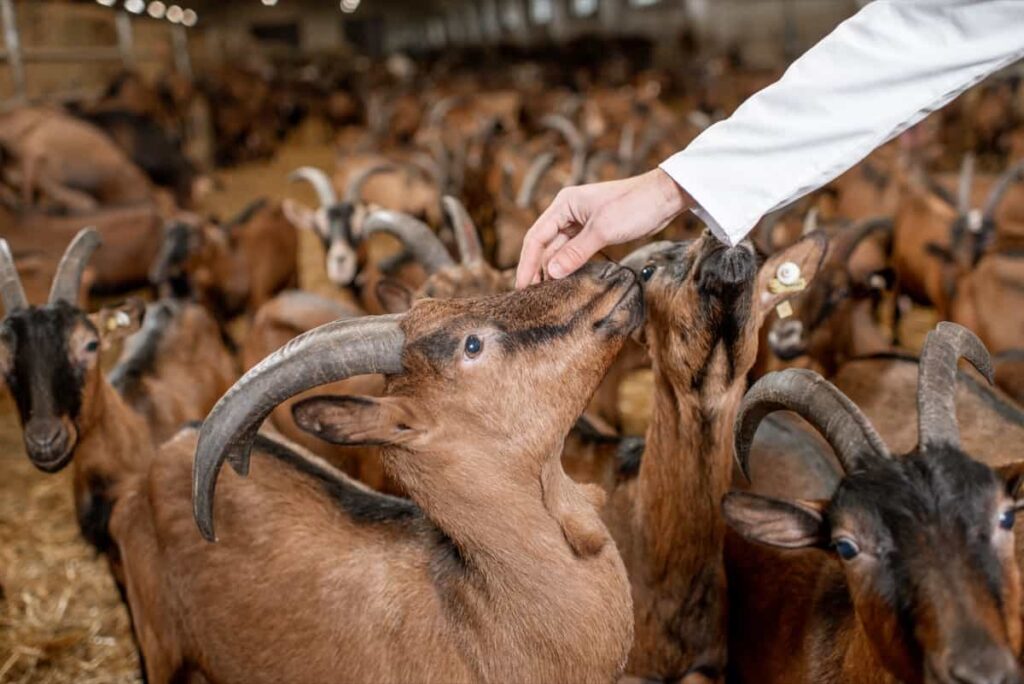Goat farming plays an important role in supporting rural economies in Nagaland while also providing employment opportunities within local communities. With its favorable climate and diverse terrain, Nagaland provides an ideal environment for raising goats. The state’s hilly landscapes, moderate temperatures, and abundant vegetation make it conducive for rearing various breeds of goats.

Steps to Start Goat Farming in Nagaland
Climate and Terrain of Nagaland Suitable for Goat Farming
Nagaland boasts a unique climate and terrain that make it ideal for goat farming. The state experiences a subtropical climate with ample rainfall throughout the year. This combination creates lush green pastures and abundant vegetation, providing an excellent source of food for goats. The hilly terrain of Nagaland offers natural grazing land and protects against harsh weather conditions.
Goats are well adapted to climbing hills and can navigate through steep slopes effortlessly. Moreover, the undulating landscape ensures proper drainage, preventing waterlogging and maintaining optimal hygiene for the animals. Nagaland also has a rich biodiversity, and this allows for diverse plant species that serve as fodder options for goats. Goat farmers in Nagaland have an added advantage due to traditional knowledge passed down through generations within local communities.
Benefits of Goat Farming in Nagaland
Goat farming has gained significant popularity in Nagaland due to the numerous benefits it offers. The main advantage is that goats are known for their high fertility rate, making them a profitable investment for farmers. With proper care and management, goats can reproduce quickly, providing a steady source of income.
Moreover, goat farming requires less space compared to other livestock farming practices. This is particularly beneficial in Nagaland, where land availability may be limited. Goats can thrive in small areas, and their adaptability to various climates makes them suitable for the hilly terrain of Nagaland. Another advantage of goat farming is its low initial investment cost. Starting a goat farm in Nagaland requires minimal capital as compared to other agricultural ventures.
Selecting the Right Breed of Goats for Your Farm
It’s important to take into account the climate and terrain of Nagaland. Certain breeds are better adapted to specific environmental conditions. Nagaland, a land of rich cultural diversity and breathtaking landscapes, is also home to a variety of goat breeds that are well-suited for different purposes. One such breed is the Sumi-Ne, which is primarily known for its high-quality fiber production. The Sumi-Ne goats have a unique coat that produces fine and lustrous wool-like fibers.
In case you missed it: Effective Goat Health Management Practices: Preventing and Treating Common Diseases

Some notable breeds include the Mizo Brown, Sangai Black, Angora White, and Konyak Red. By understanding the specific traits of each breed, farmers in Nagaland can selectively choose goats that align with their farming goals and requirements. This ensures optimal productivity and profitability on their farms.
Housing and Feeding Requirements for Goats
The housing should be sturdy and provide adequate protection from the elements. Goats need shelter from rain, wind, and extreme temperatures. Goats need a balanced diet that includes roughage, such as grass or hay, as well as concentrates, like grains or pellets. It is important to ensure that they have access to fresh water at all times. In Nagaland, where grazing land may be limited, providing sufficient quantities of nutritious feed is crucial.
Goat farmers in Nagaland also need to pay attention to the quality of feed given to their animals. It is advisable to consult with local veterinarians or agricultural experts for guidance on suitable diets for different breeds of goats. Regular monitoring of goats’ health is essential to detect any signs of illness early on. Vaccinations and deworming should be carried out according to recommended schedules.
Requirements to Setting Up a Successful Goat Farm
- Land: Ensure you have enough land for your goats to graze and roam freely. Ideally, the land should have access to good-quality pasture and clean water sources.
- Housing: Construct sturdy and well-ventilated shelters for your goats. These should protect them from extreme weather conditions and predators.
- Feeding: Develop a feeding plan that includes a balanced diet of hay, grains, grass, and mineral supplements. Make sure the feed is nutritious and easily available.
- Health Care: Regularly vaccinate your goats against common diseases prevalent in Nagaland. Establish a connection with a local veterinarian who can guide health management practices.
- Marketing Strategy: Determine potential markets for selling goat products such as meat, milk, or fiber in Nagaland or neighboring states/cities like Assam or Manipur, where there is high demand for goat products.
Health Care and Management Practices for Goats
Proper care is important for the goat’s health, which directly impacts their productivity and profitability. It is essential to provide clean and hygienic housing for your goats. Regular cleaning of sheds helps prevent the spread of diseases and parasites.
In case you missed it: Government Subsidy for Goat Farming in Nagaland: Eligibility, Documents, and Application Process

Feeding is another critical aspect of goat management. A balanced diet consisting of forage, grasses, grains, and supplements will ensure optimal growth and development. Proper hygiene during milking sessions is crucial for dairy goat farmers.
Market Opportunities for Goat Farmers
Goat farming in Nagaland presents numerous market opportunities for aspiring farmers. In addition to meeting the local demand, goat farmers in Nagaland can also tap into the wider national market. India has a growing population with an increasing interest in organic and healthy food products. This provides an excellent opportunity for Nagaland’s goat farmers to supply their products to other states.
Furthermore, there is a rising trend of niche markets, such as restaurants specializing in ethnic cuisines or health-conscious consumers seeking organic produce. Establishing strong marketing channels, such as direct selling at farmers’ markets or partnering with local restaurants, can help ensure a steady flow of customers and higher profitability.
Challenges and Solutions
One challenge that farmers may face is the lack of proper infrastructure and facilities for goat farming. This can include inadequate housing structures, feeding systems, and healthcare facilities. However, there are solutions to these challenges. Farmers can work towards improving their infrastructure by constructing suitable housing units for their goats. Another challenge that farmers may encounter is finding reliable sources of quality feed and fodder. This is especially important as goats require a well-balanced diet to thrive.
To overcome this challenge, farmers can explore options such as cultivating their fodder crops or establishing partnerships with local suppliers who specialize in providing nutritious feed for livestock. Marketing can also pose a challenge for new goat farmers in Nagaland. However, by leveraging social media platforms and building connections with local markets or restaurants that have demand for goat meat or dairy products, farmers can find lucrative market opportunities.
Government Subsidies
The Nagaland government understands the potential of goat farming and has taken initiatives to provide support to farmers in this sector. One such support comes from NABARD (National Bank for Agriculture and Rural Development), which offers financial assistance and guidance to aspiring goat farmers.
Through various schemes and programs, NABARD aims to promote sustainable livestock farming practices in Nagaland. They provide loans at affordable interest rates for setting up goat farms, purchasing high-quality breeds, constructing sheds, and buying equipment necessary for efficient farm management. Furthermore, the government encourages the formation of cooperatives or self-help groups among goat farmers.
Frequently Asked Questions (FAQ) on Goat Farming in Nagaland
How Do I Choose Healthy Goats for My Farm?
When selecting goats for your farm, look for animals that appear active and alert with shiny coats and clear eyes. Check their overall health by examining their body condition score (BCS), which indicates if they are underweight or overweight.
In case you missed it: Financial Planning and Budgeting for Goat Farming Business

What Type of Shelter Do Goats Need?
Goats require proper shelter to protect them from harsh weather conditions. Constructing a well-ventilated shed with adequate space is crucial for their well-being.
What is the Initial Investment Required for Goat Farming in Nagaland?
The initial investment for starting a goat farming business in Nagaland can vary depending on factors such as the number of goats, housing facilities, and equipment needed. It’s essential to make a detailed budget and plan accordingly.
Conclusion
Nagaland’s goat farming sector holds immense potential not only as an income-generating activity but also as a means to preserve traditional practices and contribute towards sustainable rural development. Goat farming also plays an important role in sustainable agriculture practices by helping control weed growth and preventing soil erosion through grazing activities.
- Types of Grass Growing for Goat Farm
- How to Train Goats for Milking: A Beginners Guide
- Goat Milking Practices and Equipment: A Beginner’s Guide
- Goat Farming for Fiber: Producing Mohair and Cashmere
- Maximizing Goat Milk Production: Tips for Dairy Goat Farmers
- Goat Farming as a Family Business: Strategies for Success
- Profitable Kenya Goat Breeds for Commercial Dairy and Meat Business
- Unlock the Secrets of Oberhasli Goat: Discover Raising and Management Practices
- Ultimate Guide to Myotonic Goats: Explore Profile to Raising